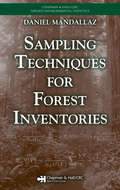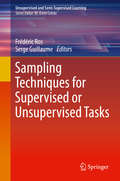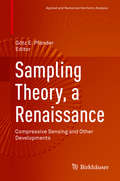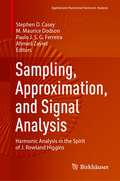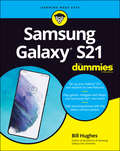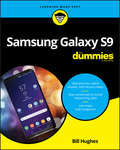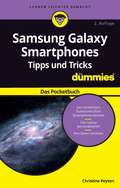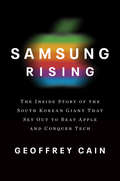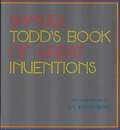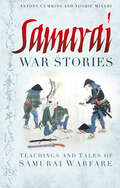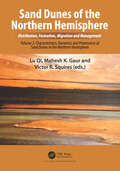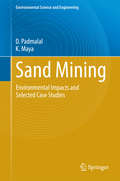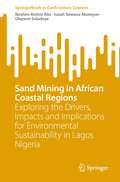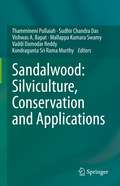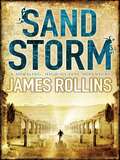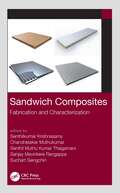- Table View
- List View
Sampling Techniques for Forest Inventories (Chapman & Hall/CRC Applied Environmental Statistics)
by Daniel MandallazSound forest management planning requires cost-efficient approaches to optimally utilize given resources. Emphasizing the mathematical and statistical features of forest sampling to assess classical dendrometrical quantities, Sampling Techniques for Forest Inventories presents the statistical concepts and tools needed to conduct a modern for
Sampling Techniques for Supervised or Unsupervised Tasks (Unsupervised and Semi-Supervised Learning)
by Frédéric Ros Serge GuillaumeThis book describes in detail sampling techniques that can be used for unsupervised and supervised cases, with a focus on sampling techniques for machine learning algorithms. It covers theory and models of sampling methods for managing scalability and the “curse of dimensionality”, their implementations, evaluations, and applications. A large part of the book is dedicated to database comprising standard feature vectors, and a special section is reserved to the handling of more complex objects and dynamic scenarios. The book is ideal for anyone teaching or learning pattern recognition and interesting teaching or learning pattern recognition and is interested in the big data challenge. It provides an accessible introduction to the field and discusses the state of the art concerning sampling techniques for supervised and unsupervised task.Provides a comprehensive description of sampling techniques for unsupervised and supervised tasks;Describe implementation and evaluation of algorithms that simultaneously manage scalable problems and curse of dimensionality;Addresses the role of sampling in dynamic scenarios, sampling when dealing with complex objects, and new challenges arising from big data. "This book represents a timely collection of state-of-the art research of sampling techniques, suitable for anyone who wants to become more familiar with these helpful techniques for tackling the big data challenge."M. Emre Celebi, Ph.D., Professor and Chair, Department of Computer Science, University of Central Arkansas"In science the difficulty is not to have ideas, but it is to make them work" From Carlo Rovelli
Sampling Theory, a Renaissance
by Götz E. PfanderReconstructing or approximating objects from seemingly incomplete information is a frequent challenge in mathematics, science, and engineering. A multitude of tools designed to recover hidden information are based on Shannon's classical sampling theorem, a central pillar of Sampling Theory. The growing need to efficiently obtain precise and tailored digital representations of complex objects and phenomena requires the maturation of available tools in Sampling Theory as well as the development of complementary, novel mathematical theories. Today, research themes such as Compressed Sensing and Frame Theory re-energize the broad area of Sampling Theory. This volume illustrates the renaissance that the area of Sampling Theory is currently experiencing. It touches upon trendsetting areas such as Compressed Sensing, Finite Frames, Parametric Partial Differential Equations, Quantization, Finite Rate of Innovation, System Theory, as well as sampling in Geometry and Algebraic Topology.
Sampling Theory: Beyond Bandlimited Systems
by Yonina C. EldarCovering the fundamental mathematical underpinnings together with key principles and applications, this book provides a comprehensive guide to the theory and practice of sampling from an engineering perspective. Beginning with traditional ideas such as uniform sampling in shift-invariant spaces and working through to the more recent fields of compressed sensing and sub-Nyquist sampling, the key concepts are addressed in a unified and coherent way. Emphasis is given to applications in signal processing and communications, as well as hardware considerations, throughout. With 200 worked examples and over 200 end-of-chapter problems, this is an ideal course textbook for senior undergraduate and graduate students. It is also an invaluable reference or self-study guide for engineers and students across industry and academia.
Sampling and Surveying Radiological Environments
by Mark E. ByrnesPrivate landowners or Federal Agencies responsible for cleaning up radiological environments are faced with the challenge of clearly defining the nature and extent of radiological contamination, implementing remedial alternatives, then statistically verifying that cleanup objectives have been met. Sampling and Surveying Radiological Environments provides the how-tos for designing and implementing cost effective and defensible sampling programs in radiological environments, such as those found in the vicinity of uranium mine sites, nuclear weapons production facilities, nuclear reactors, radioactive waste storage and disposal facilities, and nuclear accidents. It includes downloadable resources that walk you through the EPA's Data Quality Objectives(DQO) procedures and provides electronic templates you can complete and print. Sampling and Surveying Radiological Environments addresses all of the major topics that will assist you in designing and implementing statistically defensible sampling programs in radiological environments, including: Summary of the major environmental laws and regulations that apply to radiological sites, and advice on regulatory interfacing· Internet addresses where you can find regulations pertaining to each States Theory of radiation detection and definitions of common radiological terminologyStatistics and statistical software that apply to the environmental industry Details on commercially available radiological instrumentation and detection systems Building decontamination and decommissioning, radiological and chemical equipment decontamination procedures, and tank/drum/remote characterizationStandard operating procedures for collecting environmental media samples Guidance on sample preparation, documentation, and shipment Guidance on data verification/validation, radiological data management, data quality assessment (DQA)
Sampling, Approximation, and Signal Analysis: Harmonic Analysis in the Spirit of J. Rowland Higgins (Applied and Numerical Harmonic Analysis)
by Stephen D. Casey M. Maurice Dodson Paulo J. S. G. Ferreira Ahmed ZayedDuring his long and distinguished career, J. Rowland Higgins (1935-2020) made a substantial impact on many mathematical fields through his work on sampling theory, his deep knowledge of its history, and his service to the community. This volume is a tribute to his work and legacy, featuring chapters written by distinguished mathematicians that explore cutting-edge research in sampling, approximation, signal analysis, and other related areas. An introductory chapter provides a biography of Higgins that explores his rich and unique life, along with a bibliography of his papers; a brief history of the SampTA meetings – of which he was a Founding Member – is also included. The remaining articles are grouped into four sections – classical sampling, theoretical extensions, frame theory, and applications of sampling theory – and explore Higgins’ contributions to these areas, as well as some of the latest developments.
Sampling: A Centennial Celebration of Claude Shannon (Applied and Numerical Harmonic Analysis)
by Michael Robinson Kasso A. Okoudjou Stephen D. Casey Brian M. SadlerThe chapters of this volume are based on talks given at the eleventh international Sampling Theory and Applications conference held in 2015 at American University in Washington, D.C. The papers highlight state-of-the-art advances and trends in sampling theory and related areas of application, such as signal and image processing. Chapters have been written by prominent mathematicians, applied scientists, and engineers with an expertise in sampling theory. Claude Shannon’s 100th birthday is also celebrated, including an introductory essay that highlights Shannon’s profound influence on the field. The topics covered include both theory and applications, such as:Compressed sensingNon-uniform and wave samplingA-to-D conversionFinite rate of innovationComputational neuroscienceTime-frequency analysisOperator theoryMobile sampling issuesSampling: Theory and Applications is ideal for mathematicians, engineers, and applied scientists working in sampling theory or related areas.
Samsung Galaxy S21 For Dummies
by Bill HughesFeeling hamstrung by your new Samsung? Figure out how to navigate your new phone in no time Your Samsung Galaxy comes packed with features you’ll use every day, and Samsung Galaxy S21 For Dummies is your guide to exploring them. What do you want to do first? Send a text or email? Take photos and videos? Make a basic call? Play games? Shop? This handy guide can help you do all that and so much more. Get an overview of the buttons, screens, and apps that are essential to operating your new phone Manage your contacts so you can stay connected with calls, emails, or texts Surf the web and find new games and apps in the Google Play Store Customize your phone with ringtones, wallpaper, and awesome accessories Watch videos and movies, shoot your own videos, and take photos Boost your productivity with calendar, GPS, and productivity apps Secure your Samsung Galaxy with your face ID, thumbprint, and Screen Lock Not only does Samsung Galaxy S21 For Dummies describe features and walk you through steps to use your new phone, it also shows you what the screens look like and where to tap to make things happen. It’s like having a Samsung expert at your elbow. So pick up your copy today to make the most of your Samsung smartphone.
Samsung Galaxy S22 For Dummies
by Bill HughesYour step-by-step roadmap to unlocking the full potential of your new Galaxy S‘X’ Your new Samsung Galaxy S‘X’ is packed with more features than you can count. So, how should you go about using this fantastic phone to its fullest? With some friendly and expert help from Samsung Galaxy S‘X’ For Dummies! This book on Samsung’s latest version of its flagship smartphone will walk you through every important function and feature on the S‘X’. Want to make a call or send an email? Samsung Galaxy S‘X’ For Dummies will show you how to set up your accounts and contacts to help you stay in touch with your friends and family. More interested in playing some new games or using the latest app? Flip to the chapter on accessing the Google Play Store and grab your favorite downloads. You’ll find step-by-step descriptions, complete with helpful screenshots and pictures, to help you: Understand the home screen, buttons, and menus of your new phone so you can navigate it with ease Customize your phone with ringtones, wallpapers, lock screens, and widgets Improve your productivity with functional apps like Calendar and GPS Whether this is your first Samsung phone, or just the latest in a long line of them, Samsung Galaxy S‘X’ For Dummies is your secret weapon to unlocking the full potential of one of the most powerful smartphones on the market today.
Samsung Galaxy S9 For Dummies
by Bill HughesSamsung Galaxy S9 For Dummies documents all the features and capabilities of this popular smartphone, approaching them from the point of view of a user who is perhaps a bit baffled by the documentation and online support that comes with the phone. All aspects of the device are covered, from setup and configuration, to extensive use of the new features and capabilities. <p><p> Whether you’re looking for approachable guidance on the basics like texting, e-mailing, and accessing the internet, or more advanced topics like downloading apps, synching with a PC, and expanding the phone’s potential with new software releases, this trusted resource covers it all.
Samsung Galaxy Smartphones Tipps und Tricks für Dummies: Das Pocketbuch (Für Dummies)
by Christine PeytonSie sind Besitzer eines Samsung Galaxy und fragen sich, was Sie damit neben Telefonieren, E-Mailen und Surfen noch alles anstellen können? Dann ist dieses Buch genau das richtige für Sie! Erfahren Sie unter anderem, wie Sie Ihr Galaxy ganz nach Ihren Wünschen personalisieren, mit welchen Tricks die Bedienung noch einfacher geht, wie Sie die Akku-Lebenszeit verlängern, was die verschiedenen Benachrichtigungen und Symbole bedeuten und wie Sie Ihr Gerät und Ihre Daten vor Dieben und Viren schützen. Christine Peyton hat viele Tipps parat, mit deren Hilfe Sie alles aus Ihrem Samsung Galaxy herausholen. Und mit den Empfehlungen für nützliche und unterhaltsame Apps kommt auch der Spaß nicht zu kurz!
Samsung Rising: The Inside Story of the South Korean Giant That Set Out to Beat Apple and Conquer Tech
by Geoffrey CainAn explosive exposé of one of the biggest and most secretive companies in the world, Samsung, as the Korean juggernaut battles Apple and Sony to dominate the world of technology Based on years of reporting on Samsung for The Economist, The Wall Street Journal, and Time, from his base in South Korea, and his countless sources inside and outside the company, Geoffrey Cain offers a penetrating look behind the curtains of the biggest company nobody in America knows. Seen for decades in tech circles as a fast follower rather than an innovation leader, Samsung today has grown to become a market leader in the United States and around the globe. They have captured one quarter of the smartphone market and have been pushing the envelope on every front. Forty years ago, Samsung was a rickety Korean agricultural conglomerate that produced sugar, paper, and fertilizer, located in a backward country with a third-world economy. With the rise of the PC revolution, though, Chairman Lee Byung-chul began a bold experiment: to make Samsung a major supplier of computer chips. The multimillion- dollar plan was incredibly risky. But Lee, wowed by a young Steve Jobs, who sat down with the chairman to offer his advice, became obsessed with creating a tech empire. And in Samsung Rising, we follow Samsung behind the scenes as the company fights its way to the top of tech. It is one of Apple&’s chief suppliers of technology critical to the iPhone, and its own Galaxy phone outsells the iPhone. Today, Samsung employs over 300,000 people (compared to Apple&’s 80,000 and Google&’s 48,000). The company&’s revenues have grown more than forty times from that of 1987 and make up more than 20 percent of South Korea&’s exports. Yet their disastrous recall of the Galaxy Note 7, with numerous reports of phones spontaneously bursting into flames, reveals the dangers of the company&’s headlong attempt to overtake Apple at any cost. A sweeping insider account, Samsung Rising shows how a determined and fearless Asian competitor has become a force to be reckoned with.
Samuel Morse, That's Who!: The Story of the Telegraph and Morse Code
by Tracy Nelson MaurerWriter Tracy Nelson Maurer and illustrator El Primo Ramón present a lively picture book biography of Samuel Morse that highlights how he revolutionized modern technology. Back in the 1800s, information traveled slowly. Who would dream of instant messages? Samuel Morse, that’s who! Who traveled to France, where the famous telegraph towers relayed 10,000 possible codes for messages depending on the signal arm positions—only if the weather was clear? Who imagined a system that would use electric pulses to instantly carry coded messages between two machines, rain or shine? Long before the first telephone, who changed communication forever? Samuel Morse, that’s who! This dynamic and substantive biography celebrates an early technology pioneer.
Samuel Peppard and the Wind Wagon
by Stephanie M. BearceMillwright Samuel Peppard is ready to test his wind wagon invention on the prairie plains of the Midwest.
Samuel Todd's Book of Great Inventions
by E. L. KonigsburgSamuel Todd shows readers some inventions that make his day easier and better, including velcro, a thermos bottle, training wheels, backpacks, and mittens.
Samurai War Stories: Teachings and Tales of Samurai Warfare
by Antony Cummins Yoshie MinamiEnter the world of seventeenth-century Japanese warfare and the warrior elite, the Samurai. Samurai War Stories: Teachings and Tales of Samurai Warfare is a collection of three major texts, published in an English translation for the first time. These works include writings on three distinct military strata: the Samurai; the Ashigaru or foot soldier; and women in war. Including guidelines, tactics, commentaries and advice written by Samurai of the period, as well as intricate illustrations. Narratives of actual battles and sieges are included in the texts, such as the famous Battle of Sekigahara. This collection is an invaluable resource that sheds new light on the world of the legendary Japanese warrior.
San Diego Drag Racing and the Bean Bandits (Images of Sports)
by Emmanuel Burgin Colleen M. O’Connor Susan WachowiakSan Diego enjoys a long and storied race car and drag racing history, and the Bean Bandits are a huge part of that heritage. Yet their story remains buried in plain sight. Told here in photographs garnered from private, personal, and historical collections, the 1950s pioneering exploits of Bean Bandits leader Joaquin Arnett and his contributions to that racing history come to life. The San Diego native led his Bean Bandits to over 300 wins and several land speed records while competing against other local clubs, like the Prowlers, Oilers, Roadsters, and Roadrunners. Eventually, the Bean Bandits' streamliners set records on the Bonneville Salt Flats. Arnett won the first National Hot Rod Association (NHRA) Championship in 1953, was named to the International Car Racing Hall of Fame in 1992, and was awarded an NHRA Lifetime Achievement Award in 1994. Arnett and his Bean Bandits' car also graced the cover of Hot Rod magazine's special drag strip issue in 1953.
San Francisco Fire Department (Images of America)
by John GarveyIn San Francisco, history is as close as the sound of the fire engines and trucks racing by, sirens wailing. The San Francisco Fire Department took shape, as did the city, from the ashes and embers of the Great Fire of 1906. In the tumultuous seaport full of those seeking California's newly found gold, volunteer fire companies had to adapt to a teeming city full of canvas tents, wood shacks, kerosene lanterns, ocean breezes, and hilly winding streets. From a force that initially pulled hand-operated pumps and competed to be the first at a fire, traveling in horse-drawn equipment, the department has grown from a volunteer contingent of a few hundred to a company 1,800 strong and equipped to protect a city of 49 square miles, surrounded on three sides by salt water. The historic photographs of this volume document the establishment of the volunteer department on Christmas Eve 1849 and the inception of the paid force in 1866, as well as such colorful characters as Lily Hitchcock Coit, a belle who battled many a blaze with the volunteers and a portion of whose estate went to build the 210-foot Coit Tower on Telegraph Hill. Striking images, many never before published, illustrate how the fire department was affected not only by the well-known inferno of 1906 but by the six blazes that leveled the waterfront in the 1850s and a number of other fires throughout the city's history.
Sanctorius Sanctorius and the Origins of Health Measurement
by Teresa HollerbachThis open access book offers new insights into the Venetian physician Sanctorius Sanctorius (1561–1636) and into the origins of quantification in medicine. At the turn of the seventeenth century, Sanctorius developed instruments to measure and quantify physiological change. As trivial as the quantitative assessment of health issues might seem to us today – in times of fitness trackers and smart watches – it was highly innovative at that time. With his instruments, Sanctorius introduced quantitative research into the field of physiology. Historical accounts of Sanctorius and his work tend to tell the story of a genius who, almost out of the blue, invented a new medical science, based on measurement and quantification, that profoundly influenced modernity. Abandoning the “genius narrative,” this book examines Sanctorius and his work in the broader perspective of processes of knowledge transformation in early modern medicine. It is the first systematic study to include the entire range of the physician’s intellectual and practical activities. Adopting a material culture perspective, the research draws on the contemporary reconstruction of Sanctorius’s most famous instrument: the Sanctorian weighing chair. And here it departs from past studies that focus mainly on Sanctorius’s thinking rather than on his making and doing. The book also re-evaluates Sanctorius’s role in the wider process of the early transformation of medical culture in the early modern period, a process that ultimately led to the abandonment of Galenic medicine and to the introduction of a new medical science, based on the use of quantification and measurement in medical research. The book is therefore an important contribution to the history of medicine and historical epistemology aimed at historians of science and philosophy.
Sand Dunes of the Northern Hemisphere: Volume 2: Characteristics, Dynamics and Provenance of Sand Dunes in the Northern Hemisphere
by Lu Qi Victor R. Squires Mahesh K. GaurVolume 2 of the book ‘Sand Dunes of the Northern Hemisphere’ is sub-titled Characteristics, Dynamics and Provenance of Sand Dunes in the Northern Hemisphere. It brings together a vast body of information and insight into sand dune and desert systems from North Asia, Central Asia, North Africa and the Middle East. Chapters from the Russian Federation include studies on dune systems within the permafrost zone and there is a case study from temperate zone dune system in coastal Japan. Volume 2: Characteristics, Dynamics and Provenance of Sand Dunes in the Northern Hemisphere of 16 chapters in three Parts, focusses on Saharan Africa, Egypt, and Middle East and gives attention to sand mobility and encroachment with case studies from a number of countries where these matters are of concern. We also include chapters on the remote dunes in the permafrost zone and in the hyper-arid deserts of Iran. Case studies are used to highlight the characteristics of dunes and their interaction with humans in several widely divergent settings. Volume 2 concludes with some musing on the value of study of the past as key to the future and speculates on what the future might hold in the light of a warmer and drier Earth and a rise in sea level that threaten large tracts of low-lying land with marine incursions and destruction from storm surge. PART 4 Sand Mobility and Encroachment The seven chapters in this Part examine the real-world impact of sand encroachment and dune migration on people and their economic activities and the health, welfare and financial implications related to destruction of infrastructure, including human habitations. PART 5 Sand Dune Landscapes Distribution, Formation and Management Seven Case studies from several geographic regions in Africa, the Middle East, north-east Asia are presented here to demonstrate the underlying mechanisms in dune formation and the diverse approaches to their management. Human impacts such as sand mining, tourism development, combine with natural forces like climate variability to challenge the realization of an optimum management strategy. PART 6 Concluding Thoughts: Coping with an Unknown Future from a Little-known Past The two chapters in Part 6 have special roles. We are privileged to publish new research findings that are summarized here in Chapter 38 from extensive and detailed work conducted in the Kyzyl Kum, and Karakum sand seas of Central Asia. There is a strong belief that further study of the little-known past such as revealed in this study could unlock clues as to what a future Earth might look like. This leads on to speculation in Chapter 39 about the implications of what we already know about global change (not only climate change) and the impact of the Anthropocene on the dune systems, both inland and coastal. Sea level rise, marine incursions and an increase in extreme weather events will affect dune systems and sand seas on the Northern Hemisphere (and beyond).
Sand Mining
by D. Padmalal K. MayaThis book addresses most of the environmental impacts of sand mining from small rivers The problems and solutions addressed in this book are applicable to all rivers that drain through densely populated tropical coasts undergoing rapid economic growth. Many rivers in the world are drastically being altered to levels often beyond their natural resilience capability. Among the different types of human interventions, mining of sand and gravel is the most disastrous one, as the activity threatens the very existence of river ecosystem. A better understanding of sand budget is necessary if the problems of river and coastal environments are to be solved.
Sand Mining in African Coastal Regions: Exploring the Drivers, Impacts and Implications for Environmental Sustainability in Lagos Nigeria (SpringerBriefs in Earth System Sciences)
by Ibrahim Rotimi Aliu Isaiah Sewanu Akoteyon Olayemi SoladoyeThis book explores the drivers and impacts of sand mining in the coastal areas of Lagos Nigeria. Based on empirical evidence, sand mining activity is driven by a number of urbanization-related factors while sand mining impacts are underlined by a number of sustainability-related factors. Four urbanization components describe the drivers of sand mining and four sustainability components describe the impacts of sand mining in Lagos. This book concludes on the puzzling dilemma of sand mining that supports thriving urbanization but undermines environmental sustainability in Lagos. Of course, sand mining has strong implications for environmental sustainability in Lagos coastal areas. This book is of immense benefit to environmental planners, city administrators, students of environmental science and the general public who have regards for environmental management.
Sandalwood: Silviculture, Conservation and Applications
by Mallappa Kumara Swamy Thammineni Pullaiah Sudhir Chandra Das Vishwas A. Bapat Vaddi Damodar Reddy Kondragunta Sri Rama MurthyThis book collects comprehensive information on taxonomy, morphology, distribution, wood anatomy, wood properties and uses. It also discusses silvicultural aspects, agroforestry, pests and diseases, biotechnology, molecular studies, biosynthesis of oil, conservation, trade and commerce of Sandal wood. Sandalwood (Santalum album L.) is considered as one of the world's most valuable commercial timber and is known globally for its heartwood and oil. The book brings together systematic representation of information with illustrations, thus an all-inclusive reference and field guide for foresters, botanists, researchers, farmers, traders and environmentalists.
Sandstorm: The first adventure thriller in the Sigma series (SIGMA FORCE #Bk. 1)
by James Rollins'Rollins is what you might end up with if you tossed Michael Crichton and Dan Brown into a particle accelerator together' New York TimesAn inexplicable explosion rocks the antiquities collection of a London museum - and sets off alarms in clandestine organisations around the world...Lady Kara Kensington's family paid a high price in money and blood to found the gallery that now lies in ruins. And her search for answers is about to lead her into a world she never imagined existed: a lost city, buried beneath the Arabian desert, where something astonishing is waiting...A covert government operative hunting down a traitor is being drawn there. But at the end of a perilous journey lies an ageless power that can create a utopia - or tear down everything humankind has built over millennia of civilisation...'A non-stop thrill-a-minute ride' Tess Gerritsen
Sandwich Composites: Fabrication and Characterization
by Senthilkumar KrishnasamyA composite sandwich panel is a hybrid material made up of constituents such as a face sheet, a core, and adhesive film for bonding the face sheet and core together. Advances in materials have provided designers with several choices for developing sandwich structures with advanced functionalities. The selection of a material in the sandwich construction is based on the cost, availability, strength requirements, ease of manufacturing, machinability, and post-manufacturing process requirements. Sandwich Composites: Fabrication and Characterization provides insights into composite sandwich panels based on the material aspects, mechanical properties, defect characterization, and secondary processes after the fabrication, such as drilling and repair. FEATURES Outlines existing fabrication methods and various materials aspects Examines composite sandwich panels made of different face sheets and core materials Covers the response of composite sandwich panels to static and dynamic loads Describes parameters governing the drilling process and repair procedures Discusses the applications of composite sandwich panels in various fields Explores the role of 3D printing in the fabrication of composite sandwich panels Due to the wide scope of the topics covered, this book is suitable for researchers and scholars in the research and development of composite sandwich panels. This book can also be used as a reference by professionals and engineers interested in understanding the factors governing the material properties, material response, and the failure behavior under various mechanical loads.
